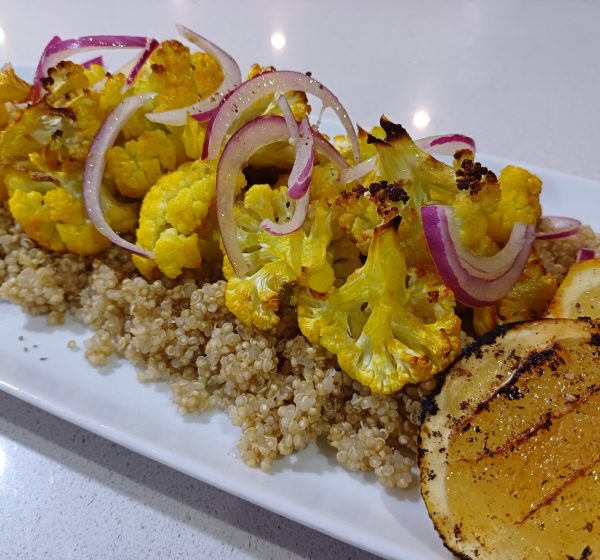Side Dish Recipes
Quinoa and Cauliflower
Cauliflower has not always been celebrated for its exceptional health benefits. This basic ingredients contains glucosinolate that has anti-inflammatory, anti-carcinogenic, antidiabetic and lipid lowering effects. Time to go back to basic and add this to your frequently consumed dishes.
Nutrition Information
Energy
233 kcal
Protein
8 g
Carbs
34 g
Sugar
6 g
Fat
9 g
Fibre
7 g

Serves: 4 Portion size: 2 cups Prep time: 5 minutes Cooking time: 25 minutes
Equipment
Cutting board Knife Pot Baking tray
Small mixing bowl Medium mixing bowl Measuring spoon Measuring cup
Ingredients
1 large cauliflower, cut into florets 2 cups quinoa, cooked ¼ red onion, finely sliced ¼ tsp tumeric, ground ¼ tsp coriander, ground ¼ tsp paprika or cayenne pepper (optional) ½ tsp salt ¼ pepper, ground 1 lemon 2 tbsp water 2 tbsp Liviana Extra Virgin Olive Oil
Method
- Pre-heat the oven or an airfryer to 200°C.
- Add all of the spices to the water. Mix well until combined. Place the Cauliflower florets into a medium bowl and pour the spice mixture over the cauliflower. Toss well until all of the florets are coated with the spice mixture.
- Place the cauliflower florets, spaced out evenly, on a baking tray and place in the oven. Cook for 25-30 minutes in the oven or 15-20 minutes in an airfryer until tender.
- Serve on top of the quinoa. Drizzle with Liviana Extra Virgin Olive Oil, season with salt and pepper and garnish with finely sliced red onion.
- For some extra flavour add charred lemon cheeks when serving. (Lemon cheeks can be placed flesh down onto a very hot pan over a high heat until it turns dark.)
Disclaimer
The recipes provided on this website are intended to be used by healthy individuals who will still use some discretion when it comes to their personal needs and requirements. While we make every effort to ensure that the information we provide is accurate, we cannot guarantee that it is free from errors or omissions. It is the responsibility of the reader to check the ingredients and ensure that they are suitable for their specific dietary requirements. We recommend that you consult with a qualified healthcare professional if you are unsure of any allergies, sensitivities, or intolerances. Additionally, while we provide suggestions for ingredient substitutions, it is up to the reader to determine whether these substitutions are appropriate for their specific dietary needs.
Spread the health, every byte counts

Wilna Eksteen
Registered Dietitian








